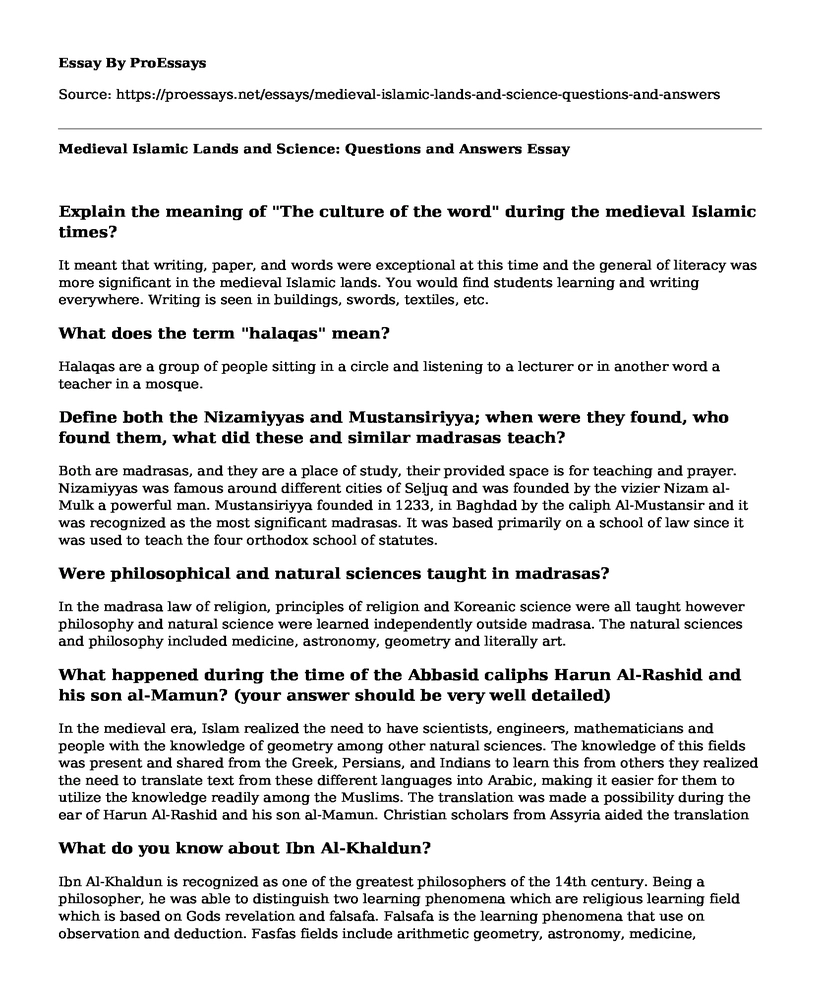Explain the meaning of "The culture of the word" during the medieval Islamic times?
It meant that writing, paper, and words were exceptional at this time and the general of literacy was more significant in the medieval Islamic lands. You would find students learning and writing everywhere. Writing is seen in buildings, swords, textiles, etc.
What does the term "halaqas" mean?
Halaqas are a group of people sitting in a circle and listening to a lecturer or in another word a teacher in a mosque.
Define both the Nizamiyyas and Mustansiriyya; when were they found, who found them, what did these and similar madrasas teach?
Both are madrasas, and they are a place of study, their provided space is for teaching and prayer. Nizamiyyas was famous around different cities of Seljuq and was founded by the vizier Nizam al-Mulk a powerful man. Mustansiriyya founded in 1233, in Baghdad by the caliph Al-Mustansir and it was recognized as the most significant madrasas. It was based primarily on a school of law since it was used to teach the four orthodox school of statutes.
Were philosophical and natural sciences taught in madrasas?
In the madrasa law of religion, principles of religion and Koreanic science were all taught however philosophy and natural science were learned independently outside madrasa. The natural sciences and philosophy included medicine, astronomy, geometry and literally art.
What happened during the time of the Abbasid caliphs Harun Al-Rashid and his son al-Mamun? (your answer should be very well detailed)
In the medieval era, Islam realized the need to have scientists, engineers, mathematicians and people with the knowledge of geometry among other natural sciences. The knowledge of this fields was present and shared from the Greek, Persians, and Indians to learn this from others they realized the need to translate text from these different languages into Arabic, making it easier for them to utilize the knowledge readily among the Muslims. The translation was made a possibility during the ear of Harun Al-Rashid and his son al-Mamun. Christian scholars from Assyria aided the translation
What do you know about Ibn Al-Khaldun?
Ibn Al-Khaldun is recognized as one of the greatest philosophers of the 14th century. Being a philosopher, he was able to distinguish two learning phenomena which are religious learning field which is based on Gods revelation and falsafa. Falsafa is the learning phenomena that use on observation and deduction. Fasfas fields include arithmetic geometry, astronomy, medicine, agriculture and physics and the term Falsafa is Greek meaning love for wisdom
Compare the 9th century Baghdad to the 11th -12th century Toledo. What did these events result with, in Western Europe as well as in the Islamic East?
In the 9th century Bagdad, begin to acquire knowledge from other cities and translation of books to Arabic was introduced. The new learning was necessary in learn to manage the state resources. By the 12th century, science, mathematics and geometry education began to grow to lead to the establishment of scholars such as al-Khwarizmi. The growth of knowledge in Islam land to growth of Bagdad as a translation center. Education was now diffusing from Islamic territory to Europe. Arabic work was for example translated into Medieval Latin. As a result in Europe, there was increased used of numerals which replaced the traditional abacus
What was the major event in the 9th century Baghdad's "Dar Al-Hikmah," the caliph's house of knowledge? Incorporate what you know about al-khawarizmi.
Al-khawarizmi was great geographer and mathematician in Bagdad. He introduced the Hindu numerals in Islamic lands although most of his mathematics did not survive in Arabic. Using Al-khawarizmi mathematics knowledge, people were able to do multiplications and divisions swiftly. Other scholars of the time such as Al-uqlidisi, Ibin Labban, and others built on his expertise and introduced new mathematical methods. The knowledge diffused to the west and by 10-12th-century Al-khawarizmi works and books had spread to parts of Spain. His work was quite famous and highly translated into Hebrew, and Latin languages and the work was built on by more scholars as time passed introducing mathematics such as algorithm among others.
Cite this page
Medieval Islamic Lands and Science: Questions and Answers. (2022, Apr 14). Retrieved from https://proessays.net/essays/medieval-islamic-lands-and-science-questions-and-answers
If you are the original author of this essay and no longer wish to have it published on the ProEssays website, please click below to request its removal:
- Education Is the Secret Key: Essay Sample
- Theology: Discussion on Theology of Miracles
- The Space Shuttle Challenger Explosion Essay Example
- Race Relations in the Colonial America Paper Example
- The Mistreatment of Africans in Nigeria Essay Example
- Essay on Napoleon's Russian Campaign: Burning of Soldiers and Historian's Investigation
- Report Example on Ion Exchange Chromatography







